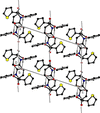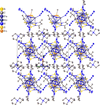issue contents
June 2024 issue

Cover illustration: Mental health is one of the most important health concerns of our times due to the variety of factors that trigger conditions such as depression, anxiety, addiction and post-traumatic stress disorder (PTSD), among others. The treatment of such conditions presents enormous challenges because they affect people of all ages and all social and economic groups. The situation is aggravated by poverty, civil conflicts, stress in the workplace and in the professional activities of the individual (such as sports, the entertainment business, etc.). Therefore, a great deal of research involves finding new approaches to treat these conditions, among them psychedelic-based therapies. In this issue, Zeller, Parent & Schultheiss [Acta Cryst. (2024). E80, 590–595] present a modern-day re-determination of the structure of polymorph I of anhydrous psilocin and the structure of polymorph II, reported here for the first time. Psilocin is the primary metabolite of psilocybin, a naturally occurring psychedelic compound. In both polymorphs, the molecules are present as the phenol-amine tautomers. However, there are significant differences in their conformations, hydrogen-bonding patterns, presence of whole-molecule disorder in Form II, among other interesting features.
research communications

























































 journal menu
journal menu
















































